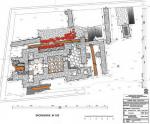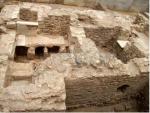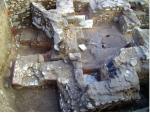Summary (English)
APOLLONIA – SOZOPOLIS (Tsonya Drazheva, Dimitar Nedev – am_sozopol@abv.bg) The Late Antique public baths built in opus mixtum and situated to the west of the three-nave basilica were thoroughly explored. The outer walls were 1 m wide and the interior walls were 80 cm wide, preserved up to 2.80 m in height. The building was 15.50 m long and 6.40 m wide, with four parallel rooms arranged in a line. There was a yard from the northern side of the baths, 11.50 m by 3.70 m in size, paved with bricks arranged over a layer of mortar, with an entrance with a staircase 2.20 m wide with four steps constructed of ashlars. Initially the building had three parallel rooms arranged in a line. Eastern Room 2 was 3.65 m by 2.45 m in size with two pools plastered with mortar. Central Room 3 measured 2.75 m by 2.95 m. Western Room 4 measured 2.90 m by 2.85 m with two pools faced with marble veneer. Rooms 3 and 4 had hypocaust and their floors were paved with stone slabs (including marble spolia from an Early Christian basilica) placed over small columns. Judging from the pottery and the coins, the baths were built in the beginning of the 6th century AD and were reconstructed during the second half of the 6th century AD and existed until the middle of the 7th century AD when the building was destroyed by a fire. During the second half of the 6th century AD, Room 1, 5.65 m by 2.70 m in size, was added on the eastern side of the baths. A coin hoard was discovered under its floor. The building of the 4th century BC, located to the north of the baths and 12 m by 7.30 m in size, was thoroughly explored. Its walls were constructed in rubble masonry and were 60 cm wide, preserved up to 1.10 m in height. The finds included sherds, including from amphorae, amphora stamps and copper slag.
- Tsonya Drazheva - Regional Museum – Burgas
- Dimitar Nedev - Archaeological Museum in Sozopol
Director
Team
Research Body
- Archaeological Museum in Sozopol
- Regional Museum – Burgas






![Download [PDF]](/excavation/skins/fasti/images/results/download_sml.png)

